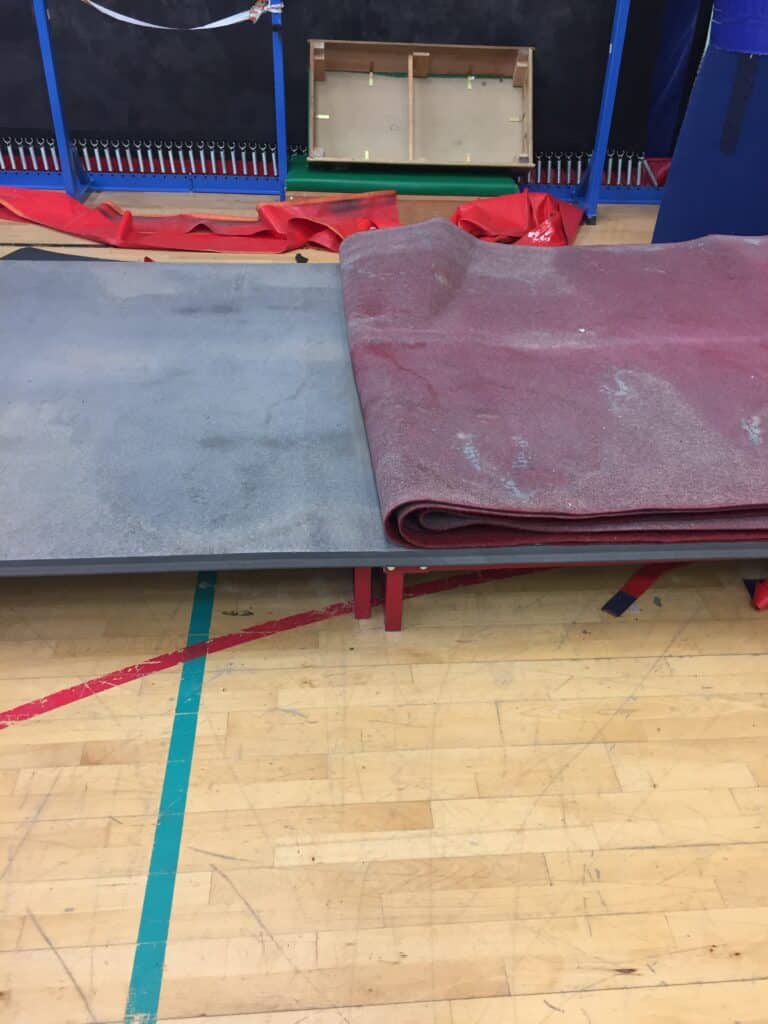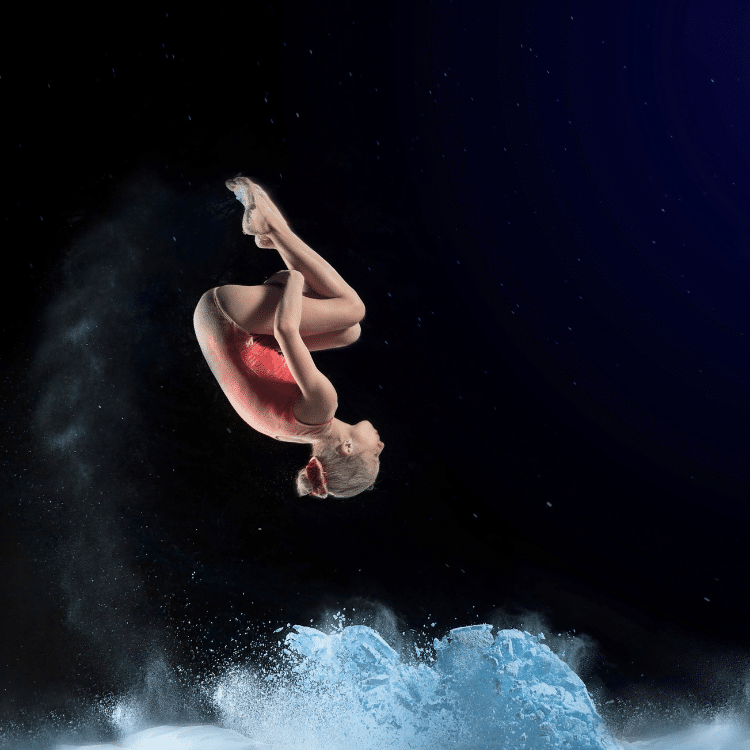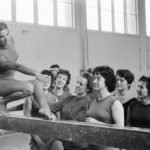
In this article, I dive into a discipline competed by both male and female gymnasts – Power Tumbling (TUM). If you are familiar with other gymnastics disciplines you will realize that Tumbling skills are found in pretty much every other discipline.
But Tumbling is also a stand-alone discipline and can be known as Power Tumbling.
I’ll be exploring all aspects of this powerful and spectacular type of gymnastics and how it became a discipline in its own right.
Let’s jump into the details of Power Tumbling!
Power Tumbling Overview
Tumbling is the performance of dynamic, acrobatic movements such as cartwheels, somersaults and handsprings. Advanced gymnasts can link several skills together to make a routine or tumble run that flows smoothly and without hesitation.
At a basic level, tumbling can be performed without apparatus, even on grass or at the beach! Artistic gymnasts will include tumbling as part of their floor routines on a sprung floor.
Some gymnasts choose to specialize in Tumbling which is also known as Power Tumbling. This type of Tumbling is performed on a long Tumble Track with matting at the end as opposed to the square-shaped spring floor used in Artistic gymnastics.
Tumbling Tracks
A Tumble Track is a 25-meter runway, 2 meters wide with extra bounce helping tumblers to jump higher and perform somersaults.
A full-length Tumble Track approved by the FIG will also have a 10-meter run which is not sprung but allows tumblers to sprint into the first skill.
There will also be an 8×3 meter matted landing area at the end of the tumble track which tumblers aim to land their final skill onto.
Tumble tracks can be shorter than the full length 25 meters. These shorter tracks can be used by gymnasts to practice shorter tumbles such as the ones used in Artistic floor routines. Professional gyms can also use foam pits at the end of the tumble track instead of a landing mat. This allows for safer landings, especially when learning new skills.
Tumblers also use inflatable Air Tracks during training as it helps get even more flight and learn new skills. Check out my article on Why Air Tracks are worth it here.
Tumble Track Construction
There are two main parts of a Tumble track – the frames and the top mat.
The frames are usually made from steel and have several fiberglass rods spanning the width of the frame. A full-length tumble track will have up to 20 individual sections of the frame that are placed next to each other.
Newer versions of tumble tracks such as the Russian Skakun track have modified the round rod into a flatter surface with plastic ‘pressure distributors’. These create an even bouncier rebound from the track.
The top mat of a tumble track is made from foam with a carpeted surface bonded to the top. The carpet surface is what the tumbler makes contact with and cushions the impact. The top mat is very similar to Flexi roll mats made by Dollamur, except there is no need for the flex design. This is because full-length tumble tracks are usually found in dedicated gymnastics facilities with no need to be rolled up and stored.

The Tumble track frames and top mat are secured together using short strips of Velcro that attach to the carpet surface on the top mat.
Gymnastics v Tumbling
Lots of people ask ‘Which is better – Gymnastics or Tumbling?’ This all depends on personal choice and if you are wondering which is better for your child you should also consider which one they enjoy the most.
There is no right or wrong answer as both are excellent!
If you are not sure which class to take then it is always a good idea to try both before making your mind up. Artistic Gymnasts will use all of the apparatus including Bars, Vault and Beam. A Tumbler will only use the tumble track with maybe a trampoline or fast track to help with learning new skills.
If a gymnast really wants to learn the apparatus then gymnastics is for them. However, if flips and back handsprings are more their thing, tumbling could be the better option.
At an elite level, Artistic Gymnastics requires an intense training schedule of up to 40 hours per week. An elite-level tumbler will probably train around half that amount so if the high workload is not a problem, gymnastics could be for you.
Power Tumbling in the Olympics
Tumbling is not currently an Olympic sport. It was included in the 1932 Los Angeles Olympics however this is the only time Tumbling has been included at the games. Rowland Wolfe (USA) was the winner at the 1932 games and is, therefore, the only ever Olympic Tumbling champion to date.
Lots of people ask ‘Why is Tumbling not an Olympic sport?’ To understand the reason you must first look at the process of selecting Olympic events by the IOC (International Olympic Committee). The IOC decides what is included and what’s not included at each Olympiad and for Gymnastics they work with the FIG to make a decision.

Since the 2000 Olympics, three disciplines have been chosen; Artistic Gymnastics, Rhythmic Gymnastics and Trampoline. For the 2024 Paris Olympiad, the FIG also proposed that Acrobatic Gymnastics, Aerobic Gymnastics and Parkour should be included so Tumbling wasn’t even put forward. Incidentally, the IOC rejected the proposal of extra gymnastics events and stuck with the familiar three disciplines.
This is because adding more events requires more time, resources and facilities and there is already a lot of pressure to keep within the existing three-week timetable.
The IOC also has a cap in terms of the overall number of athletes at the games (currently around 10,500) and tries to have a balanced amount of male and female athletes. For a new gymnastics discipline such as tumbling to be added to the Olympics, it would have to replace an existing gymnastics event, which would probably be Rhythmic as this is the least popular of the existing events (sorry Rhythmic fans!).
Tumbling would also have to have a broader representation from each continent. Currently, there are not many tumblers from Africa and South America meaning the two continents have very little representation. The IOC would not look favorably at the lack of representation.
Because Tumbling is not an Olympic sport, tumblers work towards the World Championships and World Games.
Power Tumbling Origins
Organized Tumbling can be traced as early as the 1880s when the Amateur Athletic Union (AAU) in the USA included it in events it ran. However, the origins of Tumbling can even be found in Ancient Greek and Roman military training exercises. In these times Gymnastics and Tumbling were considered a great way to build strength, power and stamina but they weren’t considered a sport in the same way we do today.
During the medieval period, Tumbling was considered entertainment by the nobility as they watched Court Jesters perform but there was still no concept of it as an organized sport.

Fast forward to the 20th century and Tumbling, just like other types of gymnastics became regulated and organized in a format similar to what we see today. The current governing body, the FIG, took over the running of the sport in 1999. Before that, Power Tumbling was regulated by the International Trampoline Federation (ITF) since the 1960s.
It was during the 1960s and 1970s that Tumble Tracks started to develop into something like the modern versions we see today as opposed to simple mats or artistic sprung floors. Variations have even included skis instead of the fiberglass rods we are now familiar with.
As the Tumble Tracks developed they became more powerful and allowed for the performance of more and more advanced skills which is a pattern across all gymnastics disciplines in the mid to late half of the 20th century.
Power Tumbling Competition Scoring
An elite-level FIG competition will require Tumblers to perform two separate tumble runs. Within each tumble run, eight skills are performed. These almost always start with a Round-Off and finish with a somersault. Senior men and some senior women will also include somersaults in the middle of the tumbling run which are known as transitions.
As with most types of gymnastics, two types of judges add their scores together to make a total score.
Difficulty judges give the run a difficulty score (DV). They do this by noting down which skills have been performed and using the FIG Code of Points to add a value for each skill.
Execution judges look at how the tumbling run has been performed and award it a score out of 10. The E-score will be lower if tumblers make errors like falling or stepping on landing, have poor form in their skills or lack speed and height.
In a panel of 5 execution judges, the top and bottom scores are disregarded to avoid any unusually high or low scores counting toward the final score.
Tumblers are required to perform one straight pass (no twists) and one twisting pass (with twists).
The hardest Power Tumbles
The hardest Power Tumbles will have two somersault transitions and an end skill, making a total of three somersaults in one run.
- Miller – Double layout with three twists. Named after Wayne Miller (USA).
- Killer – Double layout with four twists. A Miller plus an extra twist.
- Triple Back – A triple somersault in either Tuck or Pike position
Examples of the hardest full tumble runs:
- Round Off, Double-Double Layout, Whip Back, Whip Back, Double-Double Layout, Whip Back, Back Handspring, Miller.
- Round Off, Double Layout, Whip Back, Whip Back, Double Layout, Whip Back, Back Handspring, Triple Back.
The Best Power Tumblers
The greatest Tumblers of all time include:
- Song Yang (China)
- Jia FangFang (China)
- Viktor Kyforenko (Russia)
- Tagir Murtazaev (Russia)
- Andrey Krylov (Russia)
- Kristof Willerton (GBR)
- Damian Walters (GBR)
- Anna Korobeinikova (Russia)
- Lucie Colebeck (GBR)
- Chrystel Robert (France)
- Jill Hollembeak (USA)
- Jozef Wadecki (Poland)
- Jon Beck (USA)
- Steve Elliott (USA)
FAQs
What do you do in power tumbling gymnastics?
Power Tumblers perform a series of skills all linked together along a sprung tumble track. The most common skills used are round-off, Back Handspring, Whip Back and Backward somersaults. At an elite level, the somersaults will include doubles, triples and twists.
How many levels are there in power tumbling?
Depending on where you are based there will be different programs and levels designed to progress tumblers. In the USA there are nine levels whereas in the UK there are different pathways for regional and FIG tumblers.
When was power tumbling invented?
The earliest recognized power tumbling competitions date back to the 1880s in the USA. The mats and surfaces used in power tumbling have changed greatly since the early days from simple matting through to the fiberglass rods used today.
How do you get into power tumbling?
The best and safest way to get into power tumbling is at a local gymnastics club. Some clubs specialize in power tumbling whilst others may offer it alongside their artistic or trampoline programs. Here at Synergy we have run a successful Tumbling Programme for many years. Get started today with a free trial session!
- A Complete Guide to Gymnastics Hand Rips
 Are you tired of dealing with painful gymnastics rips on your hands from training? Look no further – this article offers a comprehensive approach to… Read more: A Complete Guide to Gymnastics Hand Rips
Are you tired of dealing with painful gymnastics rips on your hands from training? Look no further – this article offers a comprehensive approach to… Read more: A Complete Guide to Gymnastics Hand Rips - Is Gymnastics Dangerous? (Facts and Comparisons)
 Gymnastics is acknowledged as a highly technical and physically demanding sport. It inherently carries a risk of injury, which is why most coaches and clubs… Read more: Is Gymnastics Dangerous? (Facts and Comparisons)
Gymnastics is acknowledged as a highly technical and physically demanding sport. It inherently carries a risk of injury, which is why most coaches and clubs… Read more: Is Gymnastics Dangerous? (Facts and Comparisons) - The Fascinating Evolution of Gymnastics (History and Facts)
 Gymnastics is a sport that has been around for centuries and has evolved significantly throughout history. From its origins in ancient Greece to the modern-day… Read more: The Fascinating Evolution of Gymnastics (History and Facts)
Gymnastics is a sport that has been around for centuries and has evolved significantly throughout history. From its origins in ancient Greece to the modern-day… Read more: The Fascinating Evolution of Gymnastics (History and Facts) - The Ultimate Parallel Bars Skills List
 Parallel bars are one of the most challenging events in men’s gymnastics. Mastering the right moves first on parallel bars is essential to improving your… Read more: The Ultimate Parallel Bars Skills List
Parallel bars are one of the most challenging events in men’s gymnastics. Mastering the right moves first on parallel bars is essential to improving your… Read more: The Ultimate Parallel Bars Skills List - The Long-Term Effects of Gymnastics on the Body (A Complete Guide)
 While gymnastics can offer many benefits, such as improved fitness and self-confidence, many people also ask what are the Long-Term Effects of Gymnastics on the… Read more: The Long-Term Effects of Gymnastics on the Body (A Complete Guide)
While gymnastics can offer many benefits, such as improved fitness and self-confidence, many people also ask what are the Long-Term Effects of Gymnastics on the… Read more: The Long-Term Effects of Gymnastics on the Body (A Complete Guide) - What Age Does Competitive Gymnastics Start?
 Ever wondered what age does competitive gymnastics start? It’s well known that gymnasts start training at a young age to develop the skills and strength… Read more: What Age Does Competitive Gymnastics Start?
Ever wondered what age does competitive gymnastics start? It’s well known that gymnasts start training at a young age to develop the skills and strength… Read more: What Age Does Competitive Gymnastics Start?
